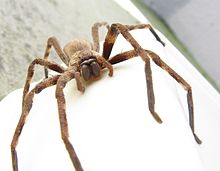Palystes
| Palystes | |
|---|---|
 |
|
| Female Palystes castaneus near Somerset West, South Africa | |
| Scientific classification | |
| Kingdom: | Animalia |
| Phylum: | Arthropoda |
| Class: | Arachnida |
| Order: | Araneae |
| Family: | Sparassidae |
| Genus: |
Palystes L. Koch, 1875 |
| Type species | |
|
Palystes castaneus Latreille, 1819 |
|
| Species | |
|
See text. |
|
| Diversity | |
| 22 species | |
See text.
Palystes is a genus of huntsman spiders, commonly called rain spiders or lizard-eating spiders, occurring in Africa, India, Australia, and the Pacific. The most common and widespread species is P. superciliosus, found in South Africa, home to 12 species in the genus. The name Palystes is derived from either the Latin palaestes or the Greek palaistes, meaning "wrestler". The genus was first described by Ludwig Carl Christian Koch in 1875.
Palystes are large spiders, with a body length of 15–36 mm, and a leg span of up to 110 mm. Their top side is covered in tan to dark tan velvety setae (hairs). The underside of their legs is banded in colour, and their legs and abdomens may be interspersed with slightly longer setae. They have a large moustachial stripe below their front eyes, and extending down their fangs.
While Palystes mostly hunt insects on plants, they commonly enter houses before rain, or during the summer, where they will prey on geckos (usually Afrogecko porphyreus in the Western Cape, or Lygodactylus capensis in the eastern parts of southern Africa). Males are regularly seen from August to December, probably looking for females.
The large round egg sacs of P. castaneus and P. superciliosus are commonly seen from about November to April. After mating in the early summer, the female makes a 60–100 mm sac out of silk, with twigs and leaves woven into it. She constructs the sac over 3–5 hours, then aggressively guards it until the spiderlings, who hatch inside the protective sac, chew their way out about three weeks later. Females will construct about three of these egg sacs over their two-year lives. Many gardeners are bitten by protective Palystes mothers during this period.
The size of Palystes spiders, combined with the banding on the underside of the legs exposed when the spider is in threat pose, give them a fearsome appearance. An experiment was done in 1959 where a P. superciliosus was allowed to bite an adult guinea pig on the nose. The guinea pig died within 7 minutes, leading to a belief that the spider's venom was dangerous. However, further research on anaesthetized guinea pigs showed that the original guinea pig had actually died of shock, rather than as a result of the spider's venom. In humans a Palystes bite is no more dangerous than a bee sting. It causes a burning sensation, and swelling which lasts for a few days. Recovery is spontaneous and complete.
...
Wikipedia
